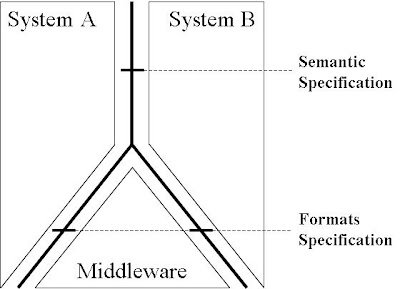Happy New Year and best wishes to you and your family for 2008.
Tuesday, 1 January 2008
Monday, 26 February 2007
What is Semantic Integration?
A Semantic Integration between applications/systems, is an integration using a shared/common Semantic Specification. A Semantic Specification is the specification of the meaning of the information to be exchanged between the applications/systems to integrate. Once the semantic specification is done, the technical schemas of the interface (e.g. format specification, XML schema, database schema, etc.) of the applications/systems will be respecively mapped/linked to the shared/common semantic specification. Then, the direct technical mapping between the technical schemas of two applications/systems should be "generate" using five inputs:
- The shared/common Semantic Specification
- The format specification, or the technical schema, of the 1st application/system
- The format specification, or the technical schema, of the 2nd application/system
- The links (semantic mapping) between the format specification od the 1st system and the shared/common semantic specification
- The links (semantic mapping) between the format specification od the 2nd system and the shared/common semantic specification
The "lambda" process
Before retrying to define what I mean by "Semantic Integration", I think I should before introduce what I called the "lambda" process. Before writing this post, I have made some research info my hard drive, and my oldest document I have found with the drawing below was from April 2002:
 Figure 1: The "lambda" process
Figure 1: The "lambda" process
The idea expressed by this drawing is that no format specification should be exchanged between the teams of the respective applications/systems to integrate. For instance, if you have to integrate a SAP system delivering IDOC with an EDI server reading EDIFACT message, ideally, the SAP team should never see the format speification (MIG or Message Implementation Guidelines) of the EDIFACT, and the EDI team should never see the IDOC format specification!
The only document that can be directly shared, between the teams of the respective applications/systems to integrate, is the semantic specifcation capturing the meaning of the information (i.e. the semantic) to be exchnaged by the two applications/systems.
Once the shared semantic specification is finalised, each team of the respective applications/systems to integrate should give to (and only to) the Middleware Team, its application-specific format specification and the links between this format specification and the semantic specification.
Thursday, 16 November 2006
A Brief History of "Sky"
Before going further, I think it would be interesting to give you a brief history of our old BizTalk 2000/2002. In order to keep this blog anonymous, I have changed the name of the company I am working for to "My Company", the name of the middleware has been changed to "Sky", and the different code-names for projects have been changed as well ;-)

At the end of the year 2000, My Company started a pilot project with the code-name "Atlanta". The goal of this project was to establish a Vendor Managed Inventory (VMI) process between My Company and its key customers. The principle of VMI is that the customer does not have to order products any more, but rather sends on a daily basis their level of stock and a forecast of their consumption (of products). Based upon that information, the supplier ensures that the customer’s stock level is always maintained sufficiently to cover their consumption. On the customer side, there is no longer a need for purchasing activities, and on the supplier side, production and delivery can be optimised. The "Atlanta" pilot project successfully went live in April 2001, and became the major supply chain tool, which today continues to be successfully implemented with several key customers.
From the beginning of the "Atlanta" pilot, we had identified that integration will be key in the success of the project. We had to integrate the VMI tool with (1) the ERP system of the customer, keeping in mind that our new customers would have different ERP systems; (2) the ERP system of the My Company pilot plant, keeping in mind that our new customers may deal with other My Company plants using different ERP systems. Consequently, we decided to include within the scope of the pilot project, the implementation of a central message broker. Microsoft BizTalk 2000 was selected as the technical platform.
After the successful go-live of the "Atlanta" project, it was recognised that My Company could take advantage of the newly implemented central message broker. In this context, the "Hermes" project was launched with the goal of establishing a central message broker, which would enable a standard (common) and reliable approach for application integration within My Company (across all regions and systems) as well as with our trading partners. After some successful pilot projects, the central message broker was accepted and it has been known as Sky, the My Company Integration Service, since April 2002.
In April 2002, a Sky Coordination Group was created, which has contributed to the exponential use of Sky for all the internal and external integration needs of My Company. Today, there is a network of 16 dedicated specialists working together, committed to maintaining a prompt and cost-effective response for all integration needs.
In addition to the growth in terms of volume, Sky started supporting more and more integrations between critical business applications and so the "Athena" project was launched in January 2004 with the goal to ensure the high availability of Sky. Since November 2004, Sky has been running on a highly available clustered infrastructure.
Today (November 2006), Sky interconnects around 280 different systems, using more than 320 different message formats. There are more than 2,000,000 messages per month exchanged across more than 2,200 routes (a route is defined by the: source, incoming format, mapping, outgoing format and destination).
Monday, 6 November 2006
Welcome on my Semantic Integration Blog
Hello World! I would like to share with you my thoughts regarding Semantic Integration...